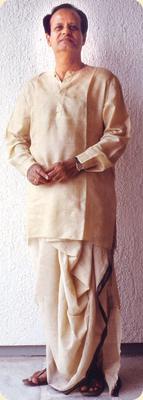Seshendra Sharma
by Saatyaki S/o Seshendra Sharma
(Hyderabad (City) Telangana(State) : India)

Seshendra:Visionary Poet of the Millennium
Seshendra Visionary poet of the millennium
http://seshendrasharma.weebly.com
October 20th,1927 - May 30th ,2007
Parents: G.Subrahmanyam (Father) , Ammayamma (Mother)
Siblings: Anasuya,Devasena
(Sisters),Rajasekharam(Younger brother)
Wife: Mrs.Janaki Sharma
Children: Vasundhara , Revathi (Daughters),
Vanamaali , Saatyaki (Sons)
----
Seshendra Sharma better known as Seshendra is a colossus of Modern Indian poetry.
His literature is a unique blend of the best of poetry and poetics.
Diversity and depth of his literary interests and his works
are perhaps hitherto unknown in Indian literature.
From poetry to poetics, from Mantra Sastra to Marxist politics
his writings bear an unnerving print of his rare Genius.
His scholarship and command over Sankrit, English and Telugu Languages has facilitated
his emergence as a towering personality of comparative literature in the 20th Century World literature.
T.S.Eliot , Archbald Macleish and Seshendra Sharma are trinity of world poetry and Poetics.
His sense of dedication to the genre he chooses to express himself and
the determination to reach the depths of subject he undertakes to explore
place him in the galaxy of world poets / world intellectuals.
----
Gunturu Seshendra Sarma:
an extraordinary poet-scholar
One of the ironies in literature is that he came
to be known more as a critic than a poet
HYDERABAD: An era of scholastic excellence and poetic grandeur has come to an end in the passing away of Gunturu Seshendra Sarma, one of the foremost poets and critics in Telugu literature.
His mastery over western literature and Indian `Alankara Sastra' gave his works a stunning imagery, unparalleled in modern Indian works. One of the ironies in literature is that he came to be known more as a critic than a poet. The Central Sahitya Akademi award was conferred on him for his work `Kaala Rekha' and not for his poetic excellence.
The genius in him made him explore `Kundalini Yoga' in his treatise on Ramayana in `Shodasi' convincingly. His intellectual quest further made him probe `Naishadha Kaavya' in the backdrop of `Lalita Sahasra Naamavali', `Soundarya Lahari' and `Kama Kala Vilasam' in `Swarna Hamsa',
Seshendra saw the entire universe as a storehouse of images and signs to which imagination was to make value-addition. Like Stephene Mallarme who was considered a prophet of symbolism in French literature, Seshendra Sarma too believed that art alone would survive in the universe along with poetry. He believed that the main vocation of human beings was to be artists and poets.
His `Kavisena Manifesto' gave a new direction to modern criticism making it a landmark work in poetics. Telugus would rue the intellectual impoverishment they suffered in maintaining a `distance' from him. Seshendra could have given us more, but we did not deserve it! The denial of the Jnanpeeth Award to him proves it.
-W. Chandrakanth
The Hindu
I
ndia's National Newspaper
Friday, Jun 01, 2007
Comments for Seshendra Sharma
|
||
|
||